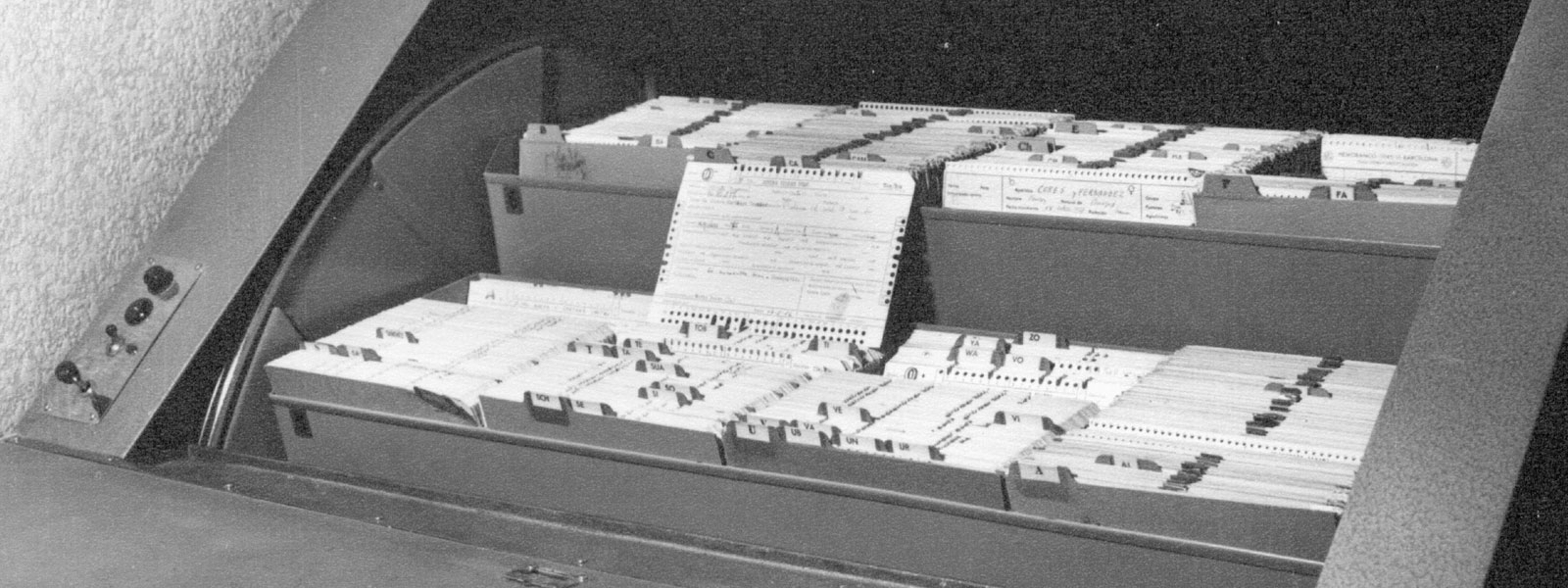The Hemoteca
Making research in hematology available, internationally
Technical file
Type of innovation: Service
Scope: Documentation
Innovation leader: Grifols i Lucas, Josep Antoni
com.grifols.labels.cabinet.year: 1955
Period: 1909-1971
Geographical scope: Spain
Economic impact: Not Applicable
Level of innovation: Evolutionary
Patent: No
Interdisciplinary connections: -
The Hemoteca was a bibliographic service created and promoted in 1955 by Josep Antoni Grifols i Lucas, which compiled a selection of the most relevant scientific articles of the main international journals dealing with hematology and hemotherapy, in a world before the internet.
Transatlantic two-way information
The service was free for doctors interested in the subjects it covered and came out of his desire to disseminate of the latest scientific advances. The Hemoteca secured an international deal that would keep vital information flowing across the Atlantic, by exchanging the monthly bibliographic compilation of the United States National Library of Medicine for two key Spanish scientific journals: Medicina Clínica and Revista Clínica Española.
Grifols i Lucas received a copy of the publications collected by the Index Medicus, reproduced the indexes of the magazines and gave a number to each article. Then, he compiled them in the form of a bulletin that he sent to healthcare professionals.
Doctors could then take a look at the bulletin and choose the articles they wanted to read, and Grifols would retrieve them from a microfilm system and send a copy to interested readers.
“The Hemoteca was free for doctors interested in the subjects it covered and came out of Josep Antoni Grifols i Lucas' desire to disseminate the latest scientific advances.”
Simplifying research for professionals
At a time when obtaining scientific information was so complicated that readers often could not even access the currency needed to buy foreign magazines, the Hemoteca was an ingenious method of meeting this academic demand, and was very favorably received by professionals. As an example of its popularity, in 1958 a total of 325 copies of this newsletter were printed.

Bibliography
Laboratorios Grifols, S.A. (1958). Estudio del coste del envío de Hemoteca correspondiente al mes de mayo de 1958. Unpublished manuscript. Barcelona: Hemobanco de Laboratorios Grifols, S.A.
Laboratorios Grifols, S.A. (1966). Memoria del Hemobanco de Laboratorios Grifols. Unpublished manuscript. Barcelona: Hemobanco de Laboratorios Grifols, S.A.
Laboratorios Grifols, S.A. (1972-1981). La Hemoteca del Hemobanco de Laboratorios Grifols, 85-94. Barcelona: Hemobanco de Laboratorios Grifols, S.A.
Laboratorios Grifols, S.A. (1972-1981). La Bioteca del Hemobanco de Laboratorios Grífols, 1-14. Barcelona: Hemobanco de Laboratorios Grifols, S.A.
Laboratorios Grifols, S.A. [ca. 1975]. Tarjetas perforadas para realizar las búsquedas bibliográficas en los servicios de Hemoteca, Bioteca y Coaguloteca. [Internal brochures]. Barcelona: Hemobanco de Laboratorios Grifols, S.A.
Laboratorios Grifols, S.A. (1976). Bureau de difusión bibliográfica del Hemobanco. Unpublished manuscript. Barcelona: Hemobanco de Laboratorios Grifols, S.A.
Bellon, J.L. (1988). Coagulación y corazón artificial. Barcelona: Masson S.A.
Grifols-Lucas, V. (2009). Amb un suro i un cordill. Vivències d'un empresari de postguerra. Barcelona: Grupo Grifols, S.A.
Greenberg, S., & Gallagher, P. (2009). The great contribution: Index Medicus, Index-Catalogue, and IndexCat. Journal of the Medical Library Association, 97(2), 108–113.
Avellà, R., & Miquel, B. (Eds.). (2015). Cuando un sueño se cumple. Crónica ilustrada de 75 años de Grifols. Barcelona: Grupo Grifols, S.A.
Related innovations
SERVICE
Rhesus factor correspondence course